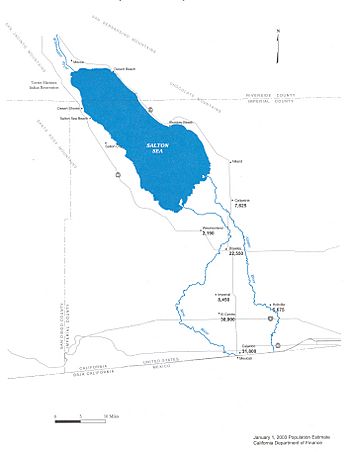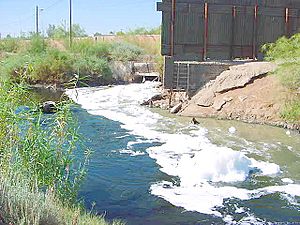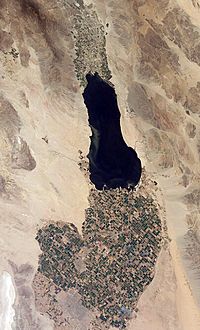New River (Mexico–United States) facts for kids
Quick facts for kids New River |
|
|---|---|

Map of the New River (left) Watershed; Alamo River on the right.
|
|
| Native name | Río Nuevo |
| Country | United States, Mexico |
| Physical characteristics | |
| Main source | near Cerro Prieto, Mexicali Municipality, Baja California, Mexico 32°22′45″N 115°14′37″W / 32.379164°N 115.243664°W |
| River mouth | Salton Sea, Imperial County, California 33°07′53″N 115°41′40″W / 33.131316°N 115.694479°W |
| Length | 125 km (78 mi) |
The New River (in Spanish, Río Nuevo) is a river that starts in Mexico and flows north into the United States. It begins near Cerro Prieto in Baja California, Mexico. The river then goes through the city of Mexicali before crossing into the U.S. at Calexico, California. Finally, it flows into the Salton Sea.
This river has been around for a very long time. But the river we see today was formed by a huge flood. This flood happened when a levee (a wall to hold back water) broke. The flood waters helped create the Salton Sea.
Sadly, the New River is known for being very polluted. Its water mostly comes from farm runoff, city waste, and factory wastewater. Many projects are working to clean up the river. These efforts include improving sewage treatment and covering parts of the river channel.
Because of the pollution, the California Office of Environmental Health Hazard Assessment has given a warning. They advise people not to eat fish caught in the New River. This is because the fish might have high levels of harmful substances. These include mercury, DDTs, PCBs, and selenium.
Contents
Where the New River Flows
The New River starts at a volcanic lake near Cerro Prieto in Mexico. This lake also supplies water to the Cerro Prieto Geothermal Power Station. The river flows about 15 miles (24 km) through Baja California. Then, it travels another 66 miles (106 km) through California. It finally empties into the Salton Sea, which is the biggest lake in California.
When the river crosses the border, about 200 cu ft/s (5.7 m3/s) of water flows. By the time it reaches the Salton Sea, the flow is about three times greater. This is because more water from farms joins the river along the way.
What Pollutes the River?
The New River's water is a mix of different things. About 18.4% comes from farm runoff in the U.S. Another 51.2% comes from farm runoff in Mexico. About 29% is sewage from the city of Mexicali. And 1.4% comes from factories in Mexico.
Near Calexico, California, where the river crosses the border, it contains many harmful things. These include chemicals, heavy metals like selenium, uranium, arsenic, and mercury. There are also pesticides (like DDT) and PCBs.
The river also carries germs that can cause serious illnesses. These include tuberculosis, encephalitis, polio, cholera, hepatitis, and typhoid. The levels of many of these harmful substances are much higher than safety standards allow.
Bacteria Levels
High levels of coliform bacteria are found in the river. These bacteria come from fecal matter. At the border, the levels can be extremely high. For example, monthly samples in 2017 showed levels from 12,000 to over 160,000 per 100 milliliters. California considers water safe for swimming if it has only 400 bacteria per 100 milliliters.
Impact on the Salton Sea
The polluted water flowing into the New River, along with farm runoff, causes problems for the Salton Sea. It leads to high levels of bacteria and large algal blooms (lots of algae growing). The Salton Sea has no outlet, so its water gets saltier each year.
The increasing saltiness, water temperature, and bacteria have caused many fish to die. This happened in 1992, 1994, 1996, 1999, 2006, and 2008. These conditions also create perfect places for diseases like avian botulism and cholera to spread among birds. This has led to many bird deaths between 1992 and 2019.
Today, the Salton Sea is very salty, about 4.4% salt. This is saltier than ocean water, which is about 3.5% salt. Because of this, many fish species cannot live or reproduce there anymore. The Tilapia might be the only fish that can survive for a short time. Without help, the Salton Sea will become even more toxic. It will remain a dangerous place for birds.
History of the River
The New River and the Alamo River, along with the Salton Sea, were greatly changed starting in 1904. Heavy rains and melting snow caused the Colorado River to overflow. This water broke through a wall meant to control the Alamo Canal. The flood poured into the Imperial Valley and created the Salton Sea. This area had flooded before, creating inland seas.
It took nearly two years for workers to control the Colorado River's flow. By early 1907, the river was back to its normal path. The flood made the New and Alamo Rivers much wider. Even after the wall was fixed, some water still flowed. The wider river channels collected farm runoff and carried it to the Salton Sea.

People have known about the New River's pollution problems since the late 1940s. The high levels of bacteria caused a bad smell where it entered the U.S. In 1944, the U.S. and Mexico agreed to work together on border sanitation problems. The International Boundary and Water Commission (IBWC) was given the job of studying the New River's pollution.
Studies in 1947 and 1948 suggested building a joint water treatment plant in the U.S. This plant would treat sewage from both Calexico and Mexicali.
Pollution Increases
As Mexicali's population grew in the 1970s, pollution got worse. The city's sewer system was not big enough. In the 1980s and 1990s, both countries tried to fix the pollution. The IBWC, which was set up in 1889 to manage the border and rivers, worked on this.
After the North American Free Trade Agreement (NAFTA) in the 1990s, factories added more pollution. Mexico had less strict environmental rules for factories, called maquiladoras. These factories often used the New River to dump their waste. Mexicali became a busy border city with over 180 maquiladoras.
In the 1990s, a project helped improve Mexicali's wastewater system. The U.S. Environmental Protection Agency (EPA) paid 55% of a $50 million upgrade. But these improvements did not treat all the waste going into the river. The remaining pollution affects both Mexico and the Imperial Valley in California. It also ends up in the Salton Sea.
In 2018, construction began on a part of the Mexico–United States barrier across the river. By 2018, most of the river in Mexicali was covered. However, it sometimes overflowed when it rained.

Environmental Challenges
The New River often smells very bad near the border. This is especially true at night and in the summer when temperatures can reach 120 °F (49 °C). The river is so polluted that technicians wear special protective gear when testing the water. U.S. Border Control agents are told to stay out of the river unless it's an emergency.
In January 2019, chemicals, heavy metals, and raw sewage were found in the New River. Trash, dead animals, and other waste line the river channel. Foam from the river can even blow into the streets of Calexico. Mosquitoes and other pests also thrive there in the summer. All these factors increase the risk of diseases.
Efforts to Improve the River
In 2006, Mexicali finished building a second wastewater treatment plant. This plant was meant to treat a large amount of raw and partly treated sewage. In May 2005, the New River was chosen for a special environmental project. The California Environmental Protection Agency (CalEPA) wanted to work with different groups to solve the pollution problems.
New Laws to Help
On July 25, 2005, California's Governor Arnold Schwarzenegger signed a new law called Senate Bill 387. This law provided money for the New River Improvement Project. This project has four main parts:
- A screen to catch trash.
- Building a covered channel next to the river in Calexico. This would move the normal river flow underground, protecting residents and allowing for water treatment.
- Creating wetlands to help clean up pollution, including pollution from the U.S.
- Building green areas and parks along the river's restored flood plain.
Future Outlook
According to water quality officials, the new wastewater treatment plant should help a lot. It will handle the raw sewage currently going into the New River. This should make the water quality better at the border, especially for germs and nutrients.
However, these projects don't fix all the problems. They don't stop trash from being dumped into the river. They also don't fully address pollution from Mexicali's wastewater lagoons, untreated factory waste, farm runoff, and city storm runoff.
Mexico plans to reuse the treated water for green areas. This will reduce the amount of water flowing into the New River at the border. Other projects will also decrease the river's flow. These changes could harm the water quality of the Salton Sea.
However, the Imperial Irrigation District believes that by the time the river reaches the Salton Sea, the pollution is "not significant." They say the water quality improves as it flows north. This is because more farm drain water is added, and natural cleaning happens over the 60 miles (97 km) journey. They also state that farm pesticides have never been found in the Salton Sea at levels high enough to be a health concern.
Images for kids
-
Map of the New River (left) Watershed; Alamo River on the right.
-
The New River at the US–Mexico border, carrying foam and mixing with wastewater from the International Drain
-
The Salton Sea, and tributaries in the Imperial Valley as seen from the Space shuttle.
See also
 In Spanish: Río Nuevo para niños
In Spanish: Río Nuevo para niños




